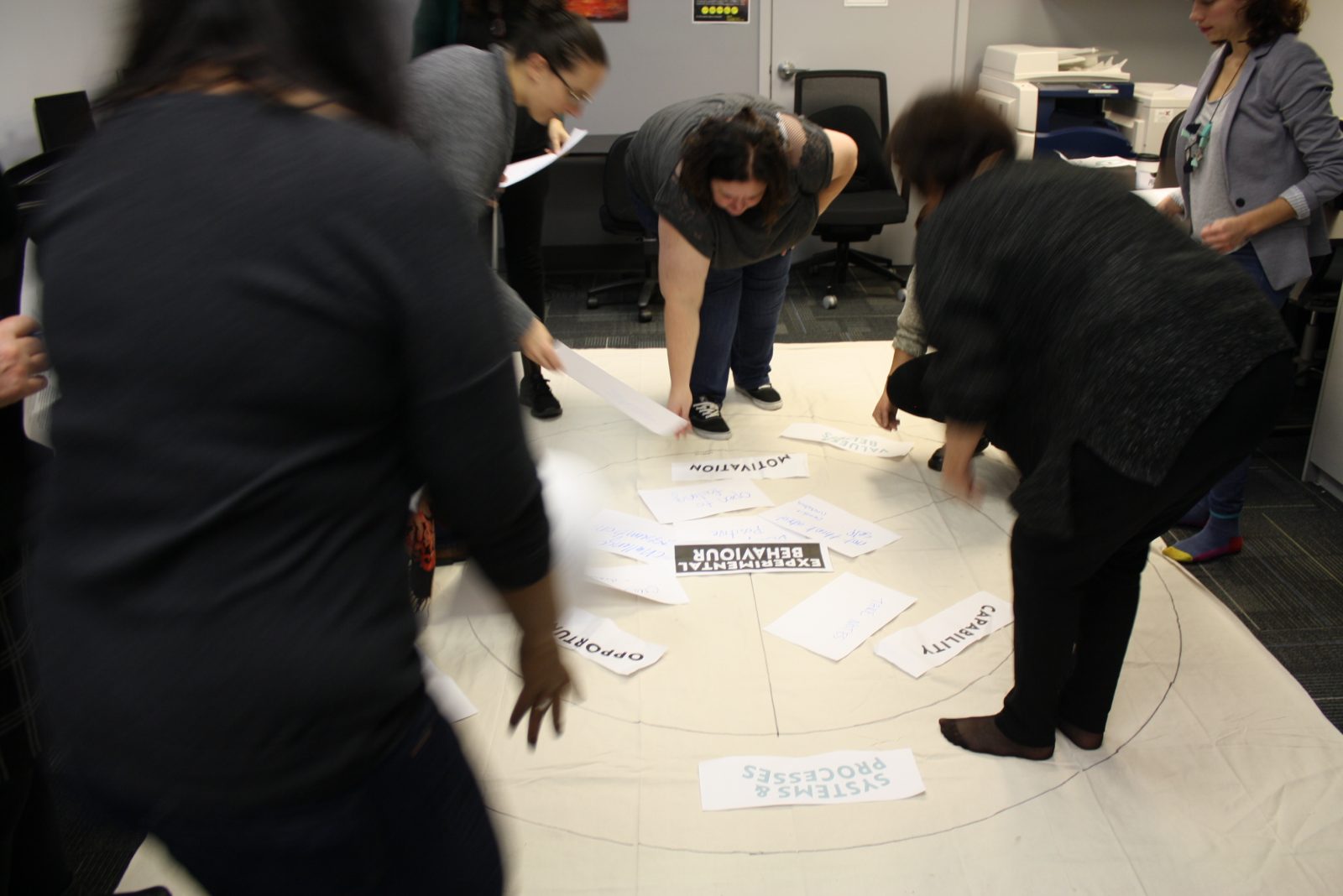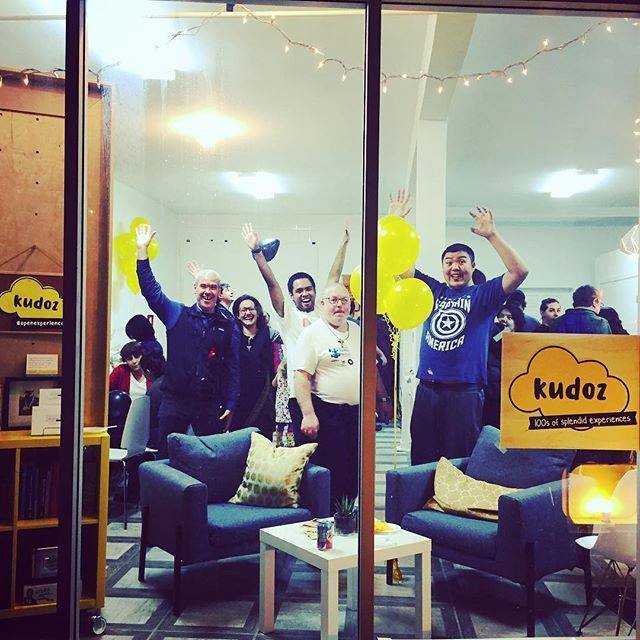Categories
1. Open learning events

One of our favorite mantras is we don’t know what we don’t know. How can we expose ourselves and practitioners from across sectors to all the different ways of knowing about and changing social realities?
Enter Open Learning Events, bite-sized introductions to the blend of anthropology, social psychology, design, and organizational change approaches that feed our bottom-up change work. In 2017, we ran 26 open learning events in Vancouver, Toronto, and Ottawa on everything from human interaction design to team routines to generative ethnography to our favorite behavior change theories to leadership and limiting beliefs. Over 279 frontline workers, researchers, designers, and civil servants took part. Thanks to this expanded network, we’ve recruited fabulous fellows and made new friends.
In 2018, we’ll road test a range of new learning formats – from field trips to reading clubs. Our ambition is to assemble a’liberal arts’ curriculum for social change – focused on broadening participants’ reference points; blending creative, analytic, and indigenous ways of knowing about the world; and practicing discernment.
2. Problems to conditions

Problem naming is the first step of most innovation, design, and policy processes. It used to be the first step in our process too. In 2017, we tested a different starting point. Rather than jump into problem identification, we first wanted to understand the conditions for critical inquiry and experimentation. Why? Well, problem naming is a pretty powerful act. We’ve seen how it can divide stakeholders and spark real resistance. In order for solutions to take hold, there must be recognition of the problem and sufficient motivation, opportunity, and capability for new things to emerge.
We didn’t invent the motivation, opportunity, and capability trifecta – that’s the inspiring work of Dr. Susan Michie from University of College London. What we have done is adapt this behaviour change framework for organizational contexts, and develop a suite of qualitative research tools to capture the conditions for experimentalism within social organizations.
In 2018, we’ll iterate the framework and our tools (our first tries were too structured) and publish a paper on why sussing out conditions for change is a critical precursor to social problem solving.
3. Aggregated ethnographic data

Fresh data is a necessary (albeit insufficient) condition for finding and sustaining novel solutions. In the past, we’ve expended a lot of time and money collecting rich ethnographic data for discrete projects. The project would inevitably end and the data would languish on our digital shelves. No longer. Data gains power with quantity and volume. One of the inherent challenges of ethnography are the small sample sizes.
In 2017, we soft launched Grounded Data: an aggregated ‘thick’ dataset containing profiles of people living with similar challenges across geographic contexts, plus visualized trends as infographics. Just last month, in December, we collected nearly 50 stories of street-involved adults living with mental health challenges and addictions in Edmonton, Alberta and Surrey, British Columbia (a huge thanks to our partners MaRS Solutions Lab, the City of Edmonton, and Options Community Services!) The enduring question, of course, is how do we collate and visualize this data for maximum use and impact?
In 2018, we’re looking forward to more ethnographic work with precariously housed adults in Toronto, with socially isolated seniors in Vancouver, and with folks engaging in the justice system in Ontario. And thanks to a small grant from the Community Fund for Canada’s 150th, we’ll also convene ethnographers, data visualizers, and coders to begin to spec out the digital platform for collecting and visually presenting qualitative data.
4. Embedded research teams

Ethnography is fun. And we cannot be the only ones having fun. So much of the energy and will to solve problems comes from being immersed in the field and seeing what’s remarkable about the seemingly unremarkable. We realized: if we want to spread new solutions, we’ve also got to spread the organizational capacity to do immersive field work and generate ideas from the ground-up. At the same time, we realized that implicates staff roles, how work is structured, and where information flows. This is how we ended up in the infrastructure building business: helping organizations to fashion new roles, routines, and information flows.
In 2017, the inaugural organizational members of Grounded Space (Burnaby Association for Community Inclusion, Kinsight, posAbilities and West Neighborhood House) set-up embedded research teams. They also established the role of Culture Curator – recognized organizational leaders who hold the space for bottom-up insights to influence organizational thinking and practice. And wow! We’ve been blown away by the quality of these teams. We’ve sourced frontline workers with PhD level training in anthropology, managers with visual media backgrounds, and staff with an open-mindedness and curiosity beautifully suited to ethnographic work. What a pleasure to bring together and leverage this talent.
In 2018, we can’t wait to nurture our cohort of Culture Curators and Embedded Researches from across member agencies. We’ll also test a few different work flows. Time remains the most scarce resource. Finding time for Culture Curators and Embedded Researchers to come together with enough regularity and enough intensity is not easy. In 2017, we tested a weekly rhythm and work flow. In 2018, we’d like to try monthly sprints, with concentrated time for teams to convene and get on the ground.
5. Scaling models

Kudoz has left the nest. After three years of incubating Kudoz, the team has spread its wings. The Vancouver Kudoz delivery team moved into their own groovy studio space, and the Kudoz tech & development team joined us at the InWithForward shed. The move was both practical and symbolic. Going forward, a Kudoz central team will provide service design, technology, and training support to local Kudoz sites.
We don’t think design ever ends. It’s got to be baked into the model as it grows. After all, we need to fulfill the promise of our Vancouver UX Design Awards. We were super honored that Kudoz won not only for best UX in the design for good category, but the overall best UX award. Read all about our award here, and watch as we took our awards on the road to thank our wonderful Kudoz community.
In 2018, we’re planning to grow Kudoz to one more locality in British Columbia, Canada. We’ll also head to New Zealand in April to explore opening our first international site. Whoa!

